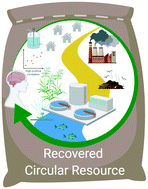Responsible science, engineering and education for water resource recovery and circularity†
Abstract
Water resource recovery is central to the circular economy framework. It underlies the transition of environmental engineering from pollution prevention to responsible innovation for sustainable systems engineering. In order to speed this transition, resource recovery and circularity need integration into new higher education curricula to train the next generation of young professionals. However, training of new concepts requires the development of new course materials and books, while integrating substantial illustrations and problems on circularity and resource recovery in new editions of existing textbooks in environmental science and engineering. Moreover, university–utility–industry partnerships are important mechanisms to bridge theoretical fundamentals to concepts for engineering practice, and to promote knowledge exchange and technology adoption between practitioners and academics. Interactive platforms should be designed to facilitate the integration and development of resource recovery and circularity concepts from science and practice into education. Consensus was built on this perspective article from interaction with the members of the Association of Environmental Engineering and Science Professors in a workshop that we organized at the AEESP Research and Education Conference 2017. Overall, this paper gives actionable roadmaps to (i) apprehend how new science and technological findings need to get integrated to sustain resource recovery and circularity in practice, along with the fact that (ii) skills sets can be engineered with relatively minor changes to existing lecture material that will have maximal impact on the scope of the thought material. It lays out (iii) how partnership with engineering practitioners can make a lecture more vivid by giving students reasoning for why the learned material is important, and (iv) how a platform for an integrated science, education, and practice can deliver them with concrete tools for practical implementation for benefits at community level.

- This article is part of the themed collections: SDG6: Clean water & sanitation, SDG13: Climate Action - Technologies to reduce greenhouse gas emissions and Environmental Science: Water Research & Technology Cover Art


 Please wait while we load your content...
Please wait while we load your content...